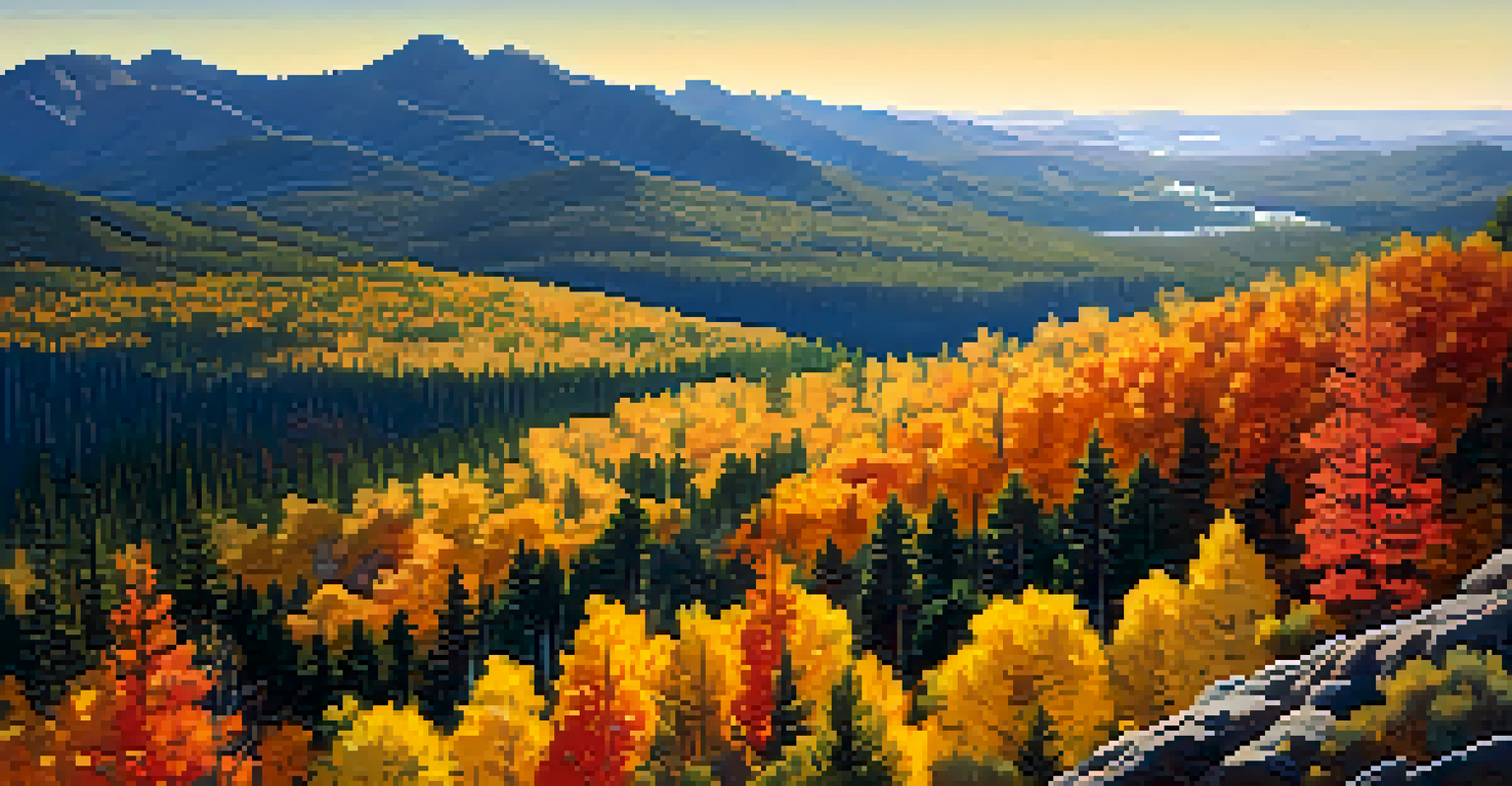Arizona's Climate: Shaping Life in the American Southwest

Understanding Arizona's Unique Climate Zones
Arizona's climate is as diverse as its landscapes, ranging from arid deserts to lush mountain regions. The state is famously known for its hot desert climate, particularly in areas like Phoenix and Tucson, where summer temperatures can soar above 100°F. However, if you venture north to places like Flagstaff, you'll find a cooler, more temperate climate, showcasing the state's varied geography.
The desert is a natural extension of our aesthetics, and we are intimately connected to it.
This diversity creates distinct climate zones that influence not just the weather, but also the flora and fauna. In the Sonoran Desert, for instance, you'll encounter cacti and other drought-resistant plants, while the higher elevations are home to ponderosa pine forests. This unique interplay between climate and geography is a fascinating aspect of Arizona's natural beauty.
Understanding these climate zones is essential for appreciating how they shape daily life in Arizona. Whether it's the way people dress, the types of crops grown, or even how homes are built, the climate plays a pivotal role in the local culture and economy.
The Impact of the Monsoon Season on Daily Life
Every summer, Arizona eagerly anticipates the arrival of the monsoon season, which typically runs from June through September. This season is characterized by dramatic thunderstorms that bring much-needed rain to the parched landscape. The sudden downpours can be both a blessing and a challenge, transforming the dry desert into vibrant ecosystems almost overnight.

For many Arizonans, the monsoon season is a time of celebration, as the rains rejuvenate the earth and cool the sweltering heat. However, these storms can also lead to flash flooding, reminding residents to respect the power of nature. Local communities often engage in preparations, reinforcing drainage systems and educating residents about safety measures during storms.
Arizona's Climate Diversity Matters
The diverse climate zones in Arizona shape everything from daily life to local culture and agriculture.
The monsoon season not only influences daily routines but also impacts agriculture. Farmers eagerly await the rains to nourish their crops, and many traditional farming practices in Arizona are closely tied to the monsoon cycle. This relationship highlights the intricate connection between climate and community resilience.
Adapting to the Desert: Water Conservation Strategies
Water scarcity is a pressing issue in Arizona, where average rainfall is significantly lower than the national average. As a result, residents have developed innovative water conservation strategies to make the most of this precious resource. Techniques such as rainwater harvesting and xeriscaping, which involves using drought-resistant plants in landscaping, are becoming increasingly popular.
In every walk with nature, one receives far more than he seeks.
Many cities are implementing strict water use regulations to encourage conservation. For example, residents may be limited in how often they can water their lawns or fill their pools. This collective effort not only helps preserve water supplies but also fosters a culture of sustainability that resonates throughout the community.
Moreover, educational programs aimed at raising awareness about water conservation are gaining traction. Schools and local organizations host workshops to teach residents about the importance of using water wisely, ensuring that future generations are equipped with the knowledge to navigate Arizona's unique climate challenges.
Cultural Influences of Arizona's Climate
Arizona's climate has a profound impact on its cultural landscape. The state is home to numerous Indigenous tribes, each with rich traditions that have been shaped by the environment. For instance, the Hopi and Navajo nations have developed agricultural practices that are uniquely adapted to the arid climate, utilizing ancient techniques to grow crops in challenging conditions.
The influence of the climate extends beyond traditional practices; it also permeates the arts, music, and cuisine of the region. Local festivals often celebrate seasonal changes, showcasing traditional dances and foods that highlight the connection between culture and climate. This blend of history and environment creates a vibrant tapestry that defines Arizona's identity.
Monsoon Season: A Double-Edged Sword
The summer monsoon season rejuvenates the landscape but also brings challenges like flash flooding.
Additionally, the state's climate attracts artists and creative individuals seeking inspiration from its stunning landscapes. The interplay of light and shadow in the desert, coupled with dramatic sunsets, has made Arizona a beloved destination for photographers and painters alike, further enriching the cultural narrative of the region.
Wildlife Adaptations in Arizona's Diverse Climates
Arizona's varied climates provide habitats for a remarkable array of wildlife. From the resilient creatures that thrive in the Sonoran Desert, such as the Gila monster and roadrunner, to the diverse bird species that inhabit the cooler mountain regions, the state is a haven for biodiversity. Each species has adapted uniquely to its environment, showcasing nature's ingenuity.
For example, many desert animals have developed nocturnal habits to avoid the extreme daytime heat, emerging at dusk to hunt and forage. Other species, like the desert tortoise, have adapted by burrowing into the ground to escape the harsh sun. These survival strategies are essential for thriving in such a challenging climate.
Conservation efforts are also crucial in protecting Arizona's wildlife. Organizations work tirelessly to preserve natural habitats and educate the public about the importance of biodiversity. By understanding the delicate balance between climate and wildlife, residents can better appreciate the rich natural heritage that Arizona has to offer.
The Role of Climate in Arizona's Economy
Arizona's climate plays a significant role in shaping its economy, particularly in sectors like agriculture and tourism. The warm weather and abundant sunshine make it an ideal location for growing crops such as citrus fruits, vegetables, and cotton. Farmers have learned to adapt their practices to maximize yields in the arid conditions, contributing to the state's agricultural output.
Tourism is another vital component of Arizona's economy, with visitors drawn to its stunning landscapes and outdoor activities. The state's climate allows for year-round enjoyment of attractions like the Grand Canyon and Sedona's red rocks. Many tourists are eager to explore hiking trails, golf courses, and resorts, all of which thrive thanks to the favorable weather.
Adapting to Climate Change
As climate change impacts Arizona, communities are developing sustainable strategies for resilience and adaptation.
However, this dependence on climate also presents challenges, especially as climate change brings shifts in weather patterns. Arizona's economy must adapt to these changes, focusing on sustainable practices and innovative solutions to ensure continued growth while protecting the environment. This adaptability is crucial for maintaining the state's economic vitality in the face of climate uncertainties.
The Future of Arizona's Climate and Its Residents
As climate change continues to impact weather patterns globally, Arizona is not immune to these shifts. Residents are already witnessing changes, such as increased temperatures, prolonged droughts, and more intense storms. These developments pose challenges for both the environment and the people living in the state, prompting discussions about sustainability and resilience.
Communities are coming together to address these challenges by developing strategies for adaptation. This includes investing in renewable energy sources, improving water management systems, and enhancing infrastructure to withstand extreme weather events. By prioritizing sustainability, Arizona aims to create a livable future for its residents amidst changing climatic conditions.

Education and community engagement are key to fostering a proactive approach to climate issues. Local organizations and schools are increasingly emphasizing environmental awareness and action, encouraging individuals to take part in initiatives that promote a healthier planet. The collective efforts of Arizonans can lead to innovative solutions that not only benefit their communities but also contribute to global climate resilience.